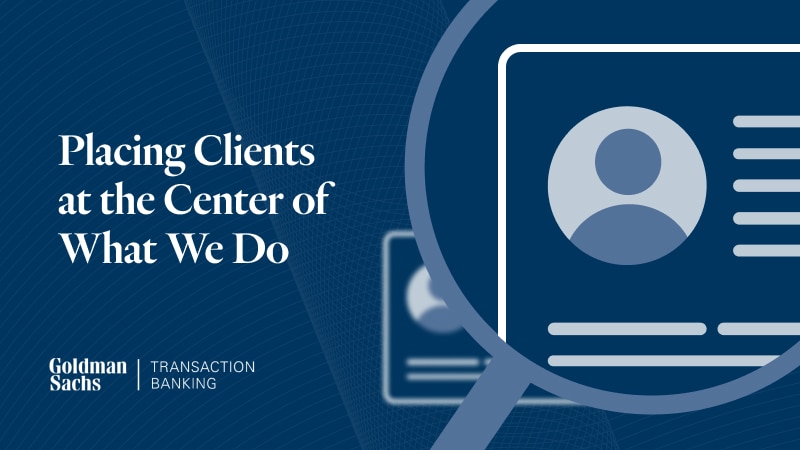Placing Clients at the Center of What We Do

By Jatin Patel, Global Head of Operations, Transaction Banking
When we seek to deliver the best possible client service at Goldman Sachs Transaction Banking (TxB), we keep one important principle in mind: The transactions we execute for clients are just a means to an end for them to run their business. A lot follows from this. Transaction banking should be an enabler. It should never come between the clients and their business.
We believe corporate clients shouldn’t have to take unnecessary time out of their day to work with their bank. Even if the service they get when they call us is friendly and efficient, we would rather clients didn’t have to reach out—didn’t have to take that time. We want to anticipate needs and make sure the solution is available and intuitively easy to use.
What does this look like? Imagine that you want to segregate funds for a new project in an account with certain products and services enabled. In such a case, no one should have to call up and work with client services to get that done. We want the entire process to be streamlined and fast, involving nothing more than a few decisions and clicks. Everyone has come to expect this kind of simplicity in everyday consumer experiences. Corporate banking has been lagging behind, and we’re striving to fix that.
Removing roadblocks
There are many ways to implement our client service ideals, starting in the provision and verification of information. When we onboard a new client, we gather any available information and documentation within Goldman Sachs, along with available external information, so the client doesn’t have to enter it again. This is consistent with our firmwide One GS initiative, our vision for a more client-centric organization.
To use a comparison with consumer banking, who would expect to have to enter contact information over again when adding a savings account to an existing checking account? Who wouldn’t be irritated if opening a certificate of deposit meant starting over because it comes from a different part of the bank? We aim for convenience on our transaction banking platform. When a client requests a new product, service or feature, we won’t ask again for information or documentation we already have, prompting instead for net new information we need. Corporate banking can often involve a lot of documentation, so this is a way we remove significant hurdles.
We know our efforts to clear away roadblocks are working because clients tell us things get done more quickly at Goldman Sachs TxB. But expediency can’t be the only goal. Proper risk management is vital, and has to be in the balance with greater speed. No one takes payments lightly, and there need to be many checks and controls. Sometimes a payment will get stopped, and for good reason. Then it comes down to how we address stopped payments as quickly as possible.
Knowing our clients
One of the common threads in streamlining the service experience is the importance of knowing and understanding our clients. We maintain subject matter expertise for the industries in which they operate, allowing us to anticipate the type of activity that will be typical and identify activity that’s anomalous.
We can learn about our clients’ activities through many channels—and these need to be coordinated. A client may be executing transactions through APIs or files, interacting by phone and email, while also working on our digital platform. In any of these touchpoints, we need to be aware of the others and have the ability to bring them together.
What’s more, we think constantly about what we can do with what we know. Our clients’ activities tell us a lot, and we use that information to make our service better. We pay attention, for example, when a client is constantly operating in a manner that results in an error or a stopped payment. That may indicate that we need to improve something to mitigate the recurring issue. Or it may suggest that the client is not using the appropriate product set with us. Rather than wait until the client gets frustrated and comes to us, we know it’s better if we can piece together what’s happening and go to the client with a solution.
To do all of this right, we need to be sure that everything we bring to the table for clients is working together. We don’t want walls up. To the extent that there are competing priorities in our organization, our goal is to make sure they are not felt or even seen by clients. Similarly, we have assembled a diverse team within Goldman Sachs TxB, and our goal is to always tap that talent fully. A question or problem may come to one part of our team, but we work hard to make sure every bit of expertise we need—whether in operations or compliance, engineering or product—gets pulled together to address the issue.
If we do all of this right, we can anticipate how our clients operate. We can make sure we are staying out of the way of their getting business done, acting as an enabler, never a roadblock.


